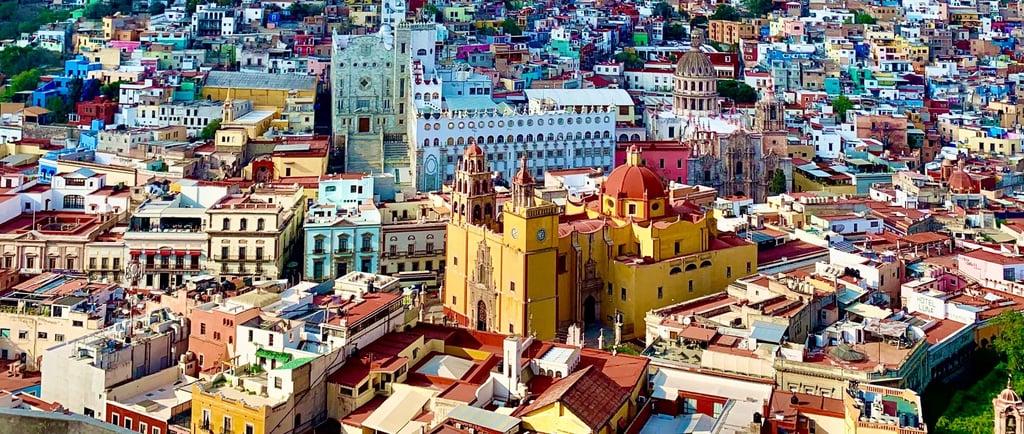Things to Know Before You Go to Guanajuato, Mexico
GUANAJUATO, MEXICO


Guanajuato Should Be On Your Radar
I’ve been coming to Mexico regularly now for nearly 30 years, and I just recently discovered Guanajuato City for the first time in 2022. I wish I had discovered it sooner because it has become one of my favourite cities in Mexico. I decided to spend an entire month here to deepen my understanding and appreciation of the city.
Easily walkable, the city is dripping in beauty, history and culture, including well-preserved art and architecture, beautiful parks and plazas, colourful winding narrow alleyways, intriguing subterranean streets, numerous festivals and shows, and enchanting myths and legends that will sweep you off your wandering feet.
The Historic Centre and adjacent silver mines were designated a World Heritage Site by UNESCO in 1988. This honour was given to the city primarily because it possesses several of the most beautiful examples of Baroque architecture in the new world, and because it boasts important technological and architectural achievements related to its historic mining operations, including the enormous Boca del Inferno (Mouth of Hell), a mine shaft 12 meters in diameter that plunges to a depth of 600 meters.
Check out the Wander Yonder YouTube video on Guanajuato embedded below this blog for an overview of what this beautiful city has to offer visitors.
Guanajuato is Safe to Visit (with Appropriate Precautions)
Unfortunately, Guanajuato City is located in a Mexican state by the same name (Guanajuato State) that is considered very dangerous. In fact, Guanajuato City is the capital of Guanajuato State. This is very unfortunate because some regions in the State of Guanajuato are unsafe, making it one of Mexico’s most violent states with some of the highest murder rates in the country, largely linked to cartel presence and ongoing turf wars. Notably, in 2023, the city of Celaya hosted 109 murders per 100,000 people, making it the most dangerous city in the entire world based on murder rates globally.
According to a Canadian Government Travel Advisory for the State of Guanajuato, people should “avoid non-essential travel due to high levels of violence and organized crime.”Similarly, according to a US Government Travel Advisory, people should “reconsider travel due to crime and kidnapping” It goes on to say, “of particular concern is the high number of murders in the southern region of the state associated with cartel violence.”
Pretty scary, right? Well, yes and no.
You definitely do not want to venture off into the dangerous areas of Guanajuato State. However, not all areas of the state are equally affected by violent crime. According to Mexican locals with a more nuanced perspective on safety and security in the area, Guanajuato City is generally considered safe and under the control of police and security forces. This becomes abundantly clear once you enter the Historic Centre and observe the widespread presence of police officers and security personnel throughout the city.
You will also be greeted by plenty of tourists, mostly Mexican families on vacation who exceedingly outnumber the gringo tourists in town. I suspect the broad travel advisories have been a significant contributor to the relative lack of gringo travellers to Guanajuato City. However, I have never felt unsafe in Guanajuato city, and in my experience, the Mexican locals and tourist are very friendly and welcoming toward foreigners.
Of course, this does not mean that you can completely let your guard down in Guanajuato City. Although it is a tourist-friendly city, it does experience a moderate level of petty crimes, including purse snatching and pickpocketing, particularly in crowded areas. Be mindful of your belongings and surroundings at all times.
Guanajuato is Located at High Altitude
Guanajuato City is located in Central Mexico, and has an average altitude of about 2000 meters (6600 feet) above sea level. Upon arrival, you may experience symptoms of altitude sickness, such as shortness of breath, tightening of your chest, headache, dizziness, nausea, fatigue, problems with sleep and loss of appetite. Symptoms usually begin within 12 to 24 hours of reaching higher elevation and get better within a day or two after your body adjusts to its new altitude. This was my experience initially.
In higher elevations, your body needs to work harder to maintain blood oxygen levels, increasing your respiration rate and leading your body to lose water faster than at sea level. Your risk of dehydration increases significantly. Places at higher altitude also have lower humidity, compounding the risk for dehydration. Drinking more water than usual is very important to alleviate symptoms and prevent dehydration. Health experts suggest increasing your water intake by an additional 1 to 1.5 litres for a total of 3-4 litres a day.
During the day, the weather is very warm, with temperatures reaching 30+ degrees celsius in the afternoons, and during the nights, temperatures can drop significantly to much lower levels, sometimes to 12 degrees celsius or less. Dress for the heat when you are exploring by day, and bring a sweater for the chilly evenings and mornings.
Guanajuato is a Vibrant University City
Guanajuato City has been a centre for education and study for nearly three hundred years. The current University of Guanajuato traces its roots back to the establishment of an education institution called the Hospice of the Holy Trinity in 1732. Over a period of more than 200 years, the site of this education institution experienced several name changes and expansions of educational programs, eventually evolving into the University of Guanajuato which has maintained its current name since 1945.
Currently, the University of Guanajuato has campuses in 14 cities throughout Guanajuato State with more than 45,000 students. The Guanajuato City campus has 20,000+ students and offers a range of programs such as architecture, art, design, economics, sciences, social sciences, humanities, law, politics, and engineering.
The main building in the historic centre is one of the most beautiful buildings that you will encounter in Guanajuato (my favourite). The same beautiful building is also featured on the 1,000 peso note in Mexico (though I've never held one before).
The university also participates in the famous International Cervantes Festival held every year in October - more on that in the next section. The student population at the University of Guanajuato has no doubt played a major role in the establishment of many eclectic bars and cafes throughout the Historic Centre, infusing the rich history and traditional culture of the city with a young and playful vibrancy, particularly at night.
Guanajuato Hosts the Annual International Cervantino Festival in October
This is one of the most significant cultural events in all of Latin America dating back the 1950s when short plays by Miguel de Cervantes called entremeses were performed in the city’s plazas. If you are planning a trip to Guanajuato around this time of year, you may wish to plan to take in this big festival (or avoid it) while visiting the city.
Cervantes is most famously known to the world as the author of Don Quixote which is considered by many to be the world’s first modern novel and one of the greatest novels of all time. The story follows the adventures of an aging nobleman who, inspired by tales of chivalry, becomes convinced he is a knight and embarks a series of misadventures accompanied by his loyal squire, Sancho Panza. Through humour and satire, the novel explores the themes of idealism, reality, societal norms and the nature of storytelling.
Throughout the city, there are statues and references to characters from the story of Don Quixote. There is even a museum with the largest collection of Don Quixote-inspired art, including sculptures, paintings, murals, ceramics and more. I really enjoyed this underrated gem of a museum and highly recommend it (free to visit on Tuesdays).
Further Reading
You may also be interested in reading the following related Wander Yonder blog posts:

